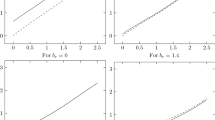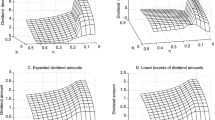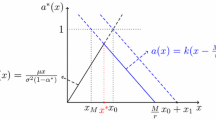Abstract
This article contributes to research dealing with the optimal dividend policy problem of a firm whose goal is to maximize the expected total discounted dividend payments before bankruptcy. We consider a model of a firm whose cash surplus exhibits regime switching, but unlike the existing literature, we exclude diffusion from our model. We assume that firm’s cash surplus follows the telegraph process, which leads to a problem of singular stochastic control. Surprisingly, this problem turns out to be more complicated than the ones arising in the models involving diffusion. We solve this problem by using the method of variational inequalities and show that the optimal dividend policy can be of three significantly different types depending on the parameters of the model.
Similar content being viewed by others
References
B. de Finetti, “Su un’lmpostazione alternativa della teoria collettiva del rischio,” in Transactions of the XV International Congress of Actuaries (New York, 1957), pp. 433–443.
R. Radner and L. Shepp, “Risk vs Profit Potential: A Model for Corporate Strategy,” J. Economic Dynamics and Control 20 (8), 1373–1393 (1996).
M. Jeanblanc-Picqué and A. N. Shiryaev, “Optimization of the flow of dividends,” Russian Math. Surveys 50 (2), 257–277 (1995).
S. Asmussen and M. Taksar, “Controlled diffusion models for optimal dividend pay-out,” Insurance Math. Econom. 20 (1), 1–15 (1997).
M. Belhaj, “Optimal dividend payments when cash reserves follow a jump-diffusion process,” Math. Finance 20 (2), 313–325 (2010).
M. I. Taksar, “Dependence of the optimal risk control decisions on the terminal value for a financial corporation,” Ann. Oper. Res. 98 (1), 89–99 (2000).
J.-P. Décamps and S. Villeneuve, “Optimal dividend policy and growth option,” Finance Stoch. 11 (1), 3–27 (2007).
J. Paulsen, “Optimal dividend payments until ruin of diffusion processes when payments are subject to both fixed and proportional costs,” Adv. in Appl. Probab. 39 (3), 669–689 (2007).
S. Sethi and M. Taksar, “Optimal financing of a corporation subject to random returns,” Math. Finance 12 (2), 155–172 (2002).
S. Goldstein, “On diffusion by discontinuous movements, and on the telegraph equation,” Quart. J. Mech. Appl. Math. 4 (2), 129–156 (1951).
M. Kac, “A stochastic model related to the telegrapher’s equation,” Rocky Mountain J. Math. 4 (3), 497–509 (1974).
E. Orsingher, “Probability law, flow function, maximum distribution of wave-governed random motions and their connections with Kirchhoff’s laws,” Stochastic Process. Appl. 34 (1), 49–66 (1990).
S. K. Foong and S. Kanno, “Properties of the telegrapher’s random without a trap,” Stochastic Process. Appl. 53 (1), 147–173 (1994).
L. Beghin, L. Nieddu, and E. Orsingher, “Probabilistic analysis of the telegrapher’s process with drift by means of relativistic transformations,” J. Appl. Math. Stochastic Anal. 14 (1), 11–25 (2001).
G. B. D. Masi, Yu. M. Kabanov, and W. Runggaldier, “Mean-variance hedging of options on stocks with Markov volatilities,” Theory Probab. Appl. 39 (1), 172–182 (1994).
Yu. V. Bondarenko, “A probabilistic model for describing the evolution of financial indices,” Cybernet. Systems Anal. 36 (5), 738–742 (2000).
A. Di Crescenzo and F. Pellerey, “On prices’ evolutions based on geometric telegrapher’s process,” Appl. Stoch. Models Bus. Ind. 18 (2), 171–184 (2002).
N. Ratanov, “A jump telegraph model for option pricing,” Quant. Finance 7 (5), 575–583 (2007).
N. Ratanov and A. Melnikov, “On Financial markets based on telegraph processes,” Stochastics 80 (2-3), 247–268 (2008).
N. Ratanov, “Option pricing model based on a Markov-modulated diffusion with jumps,” Braz. J. Probab. Stat. 24 (2), 413–431 (2010).
O. López and N. Ratanov, “Option pricing driven by a telegraph process with random jumps,” J. Appl. Probab. 49 (3), 838–849 (2012).
L. R. Sotomayor and A. Cadenillas, “Classical and singular stochastic control for the optimal dividend policy when there is regime switching,” Insurance Math. Econom. 48, 344–354 (2011).
J. Zhu and F. Chen, “Dividend optimization for regime-switching general diffusions,” Insurance Math. Econom. 53 (2), 439–456 (2013).
Z. Jiang and M. Pistorius, “Optimal dividend distribution under Markov regime switching,” Finance Stoch. 16 (3), 449–476 (2012).
J. Wei, R. Wang, and H. Yang, “On the optimal dividend strategy in a regime-switching diffusion model,” Adv. in Appl. Probab. 44 (3), 886–906 (2012).
Z. Jiang, “Optimal dividend policy when cash reserves follow a jump-diffusion process under Markov-regime switching,” J. Appl. Probab. 52 (1), 209–223 (2015).
W. H. Fleming and R. W. Rishel, Deterministic and Stochastic Optimal Control (Berlin, 1975).
W. Fleming and H. M. Soner, Stoch. Model. Appl. Probab., Vol. 25: Controlled Markov Processes and Viscosity Solutions (Springer, New York, 2006).
Author information
Authors and Affiliations
Corresponding author
Rights and permissions
About this article
Cite this article
Pospelov, I.G., Radionov, S.A. Optimal Dividend Policy when Cash Surplus Follows the Telegraph Process. Math Notes 109, 125–135 (2021). https://doi.org/10.1134/S0001434621010156
Received:
Revised:
Accepted:
Published:
Issue Date:
DOI: https://doi.org/10.1134/S0001434621010156




